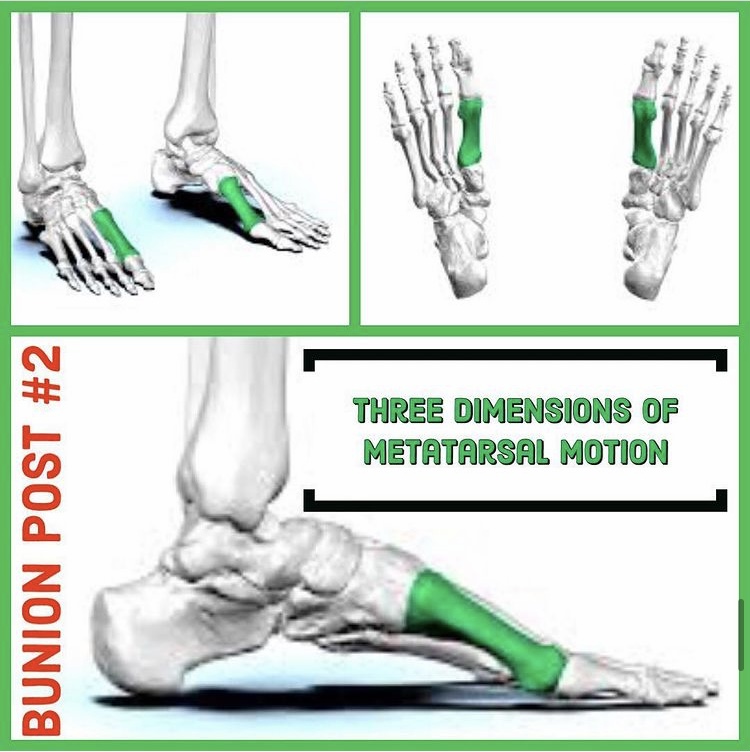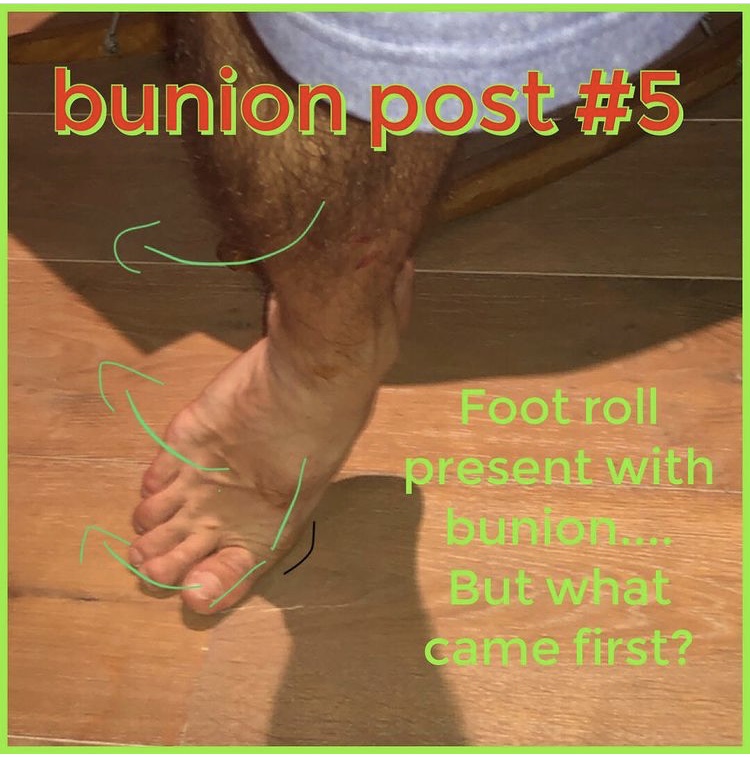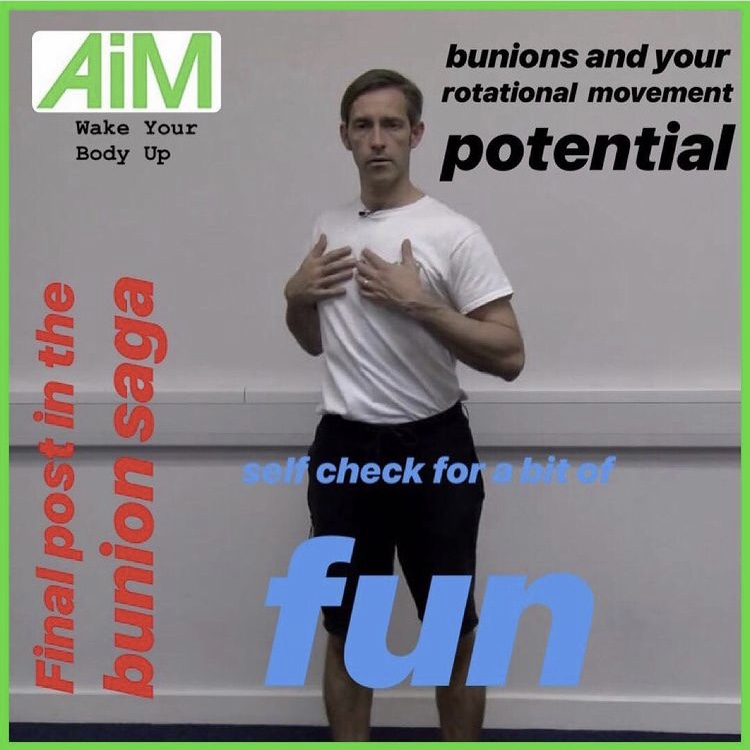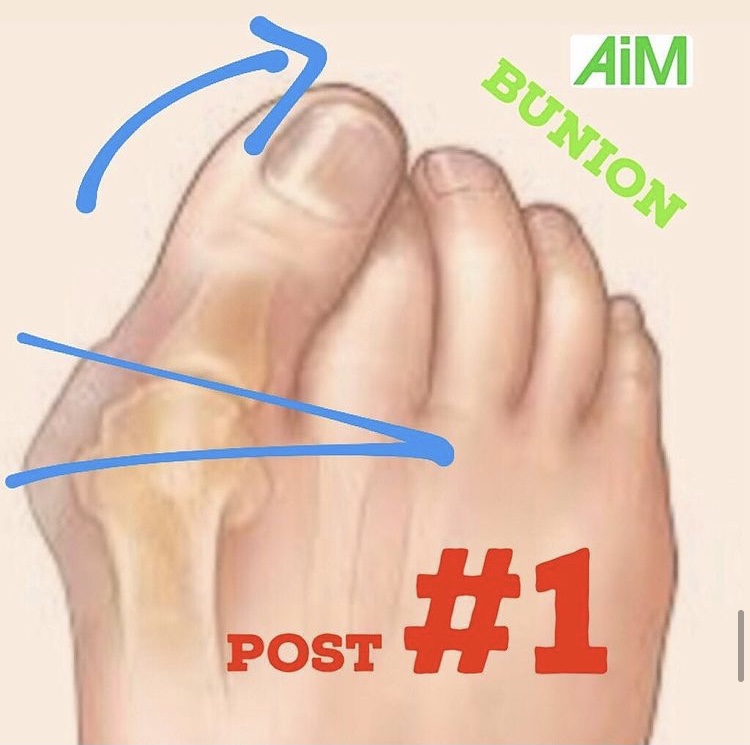Hallux Valgus
👣 When the foot pronates the forefoot abducts away from the body’s midline (see photo above). In this moment the big toe follows the movement of the forefoot – away from the body’s midline.
👣 A flatter pronated foot is known as a valgus foot. Bunions – although there do appear to be two types of bunions known as a hallux valgus.
👣 Effectively a pronated toe.
👣 A bunion is present where this movement of the toe (away from the body’s midline) is greater than it should be. It’s more valgus than it should be and we could suggest more pronated than it should be. In this case there is excess gapping at the first MTPJ (or big toe joint) – which is where a bunion is located as marked by the blue V on the image.
👣 Foot pronation as you likely know is a specific shape in the foot created by the 26 bones and 33 joints in the foot. Each of the joints on the midline of the foot should open / gap as the foot pronates. It is often the case that a bunion forms where there is excess opening in this joint. Excess opening of a joint appears to make up for a lack of such gapping at other related joints.
👣 More often than not you can look one joint up in the midfoot at the 1st metatarso-cuneiform joint to find that it is unable to open (I.e. abduct). In order to generate the necessary motion of pronation in the foot, the toe must pronate more now due to the lack of pronation in the midfoot, and the gapping will thus be excessive creating an environment for a bunion.
👣 In this scenario, the bunion is not the problem but may actually be acting as a solution (giving you more at one joint to make up for less at another).
👣 Can you get the joints of the midfoot opening in a pronation movement while mobilising the big toe joint to take the pressure off your bunion?

THREE DIMENSIONS OF METATARSAL MOTION
👣 For the purpose of this post:
Proximal = closest to belly button
Distal = farthest from belly button
👣 There are three dimension of metatarsal motion. The first metatarsal is the long bone that connects to the big toe. The metatarsal head is the big toe knuckle at the end of the first metatarsal. The space between the two is your 1st MTPJ (metatarso-phalangeal joint) where your bunions are located.
👣 A metatarsal can dorsiflex (proximal end of bone lowers to the ground) – which is normal in pronation – being stuck in this position makes it hard to get the first metatarsal head on the ground and often you see the toe press down to create contact with the ground instead. This creates gapping at the top of the toe joint and can lead to inflammation. Teaching the first metatarsal head to sit on the ground in all movement is a start point for this…
👣 The metatarsal can also invert, that is to roll on it’s axis as if the top of the long bones rolls towards the outside of the foot while the base of the bone rolls towards the inner part of the foot. This is normal again in pronation, but if stuck there with no opposition in the big toe then your toe nail may also have rolled towards the outside of your foot. Both of these contribute to poor timing on your gait and increased pressure on the bunion joint.
👣 Finally the metatarsal abduction that is necessary for pronation (see bunion post #1) is often not present in a persons forefoot. More likely the metatarsal is adducted (where the distal end of the long bone is pointing inwards to the centre line of the body). This implies that the joint proximal to the long metatarsal bone towards the mid-foot is stuck closed and the big toe adopts it’s open joint valgus position.
👣 With the metatarsal adopting one or more of these positions in your foot is a likely contributor to bunion heaven….

A SHIFTED BUNION
👣 I mentioned that there are two types of bunion. One is the valgus type already mentioned in post #1. The other is more shifted! (Translated – moved laterally)
👣 This can, again, be linked to the closed joint in the midfoot at the back of the long metatarsal bone. More adducted than it could be… This metatarsal adduction (distal end of the metatarsal pointing toward the midline of your body) is perhaps more excessive than with a valgus toe, as here the metatarsal seems to bypass the max rotational range of the toe and instead the toe slides right off the end of the metatarsal 😳
👣 Checking the bunion, I often find this type less sore, less red or swollen and certainly less calcified. You can easily palpate the end of the normal metatarsal bone. Nice 😃
👣 If you apply medial pressure to the distal end of the metatarsal (opposite to the arrow in the picture), you might find it pops back in, but doesn’t stay there. So the trick is to begin to work out how to open the joints in the midfoot and straighten the metatarsal out 😃
👣 It might help to use some tape or toe straighteners in conjunction with movements that get those midtarsal joints opening up on the inner side of your foot so that you can bring the metatarsal and the toe back in line..

SO WHY ARE THESE JOINTS CLOSING?
👣 Well this is a big question because it involves having an appreciation of inter-joint relationships in the body WHILST ALSO recognising that the body is 100% functional all of the time. This means that if something can’t, then something else will….
👣 Foot pronation is actually a whole body motion. WHAT? Yes, when the foot pronates there is one single distinct whole body pattern that occurs simultaneously. In this whole body position specific joints open and specific joints close.
👣 If the bunion joint opens excessively. One or more of the other joints that should open remain closed. Or can not open enough! This can be due to injury, learnt patterns, adaptations in the body etc… Many things.
👣 When we pronate our feet the bones on the medial aspect of the foot, knee and hip all open in the transverse rotational plane. That’s knee and hip external rotation as well as normal foot pronation. Check it out 😃
👣 PS if one of these joints is already WIDE OPEN in resting posture, it cannot open anymore… so something else is still required to open for that joints lack.
👣 I call it the Great Exchange. If something moves little, something else must move more. If something shifts forward, something else must shift back. All with an intention to create balance and keep you functional… all of the time 😃

TAKING YOUR BUNIONS OUT FOR A WALK?
👣 Did your walk create the bunion or has your bunion created your walk?
👣 It’s possible that the way you walked before the bunion showed up is what may have lead to your bunion. If this is true perhaps we can stop blaming shoes or other common explanations such as being hereditary for example (I’m not personally a fan of ‘hereditary’ as it’s a wonderful excuse and puts a full stop into any investigation). Even if it is, let’s not allow that old chestnut to prevent us from doing something about it ….
👣 Over pronation for example can mean that we turn our feet out (10 to 2 aka duck feet), this limits our ability to supinate our feet and places pressure on the inner borders meaning that we roll off the inside of the big toe as we push off, forcing that joint to open…
👣 Heavily weight bearing on one leg can also increase the load placed on that first metatarsal with each stride taken. Becoming dominant on one side of your body can arise out of injury, gait patterns, adaptation and, again, habits… perhaps a habit you learned watching a bunion laden parent walk barefoot around the house when you were young 😆. This one sided-ness can lead to a bunion on one foot and not the other…
👣 Bunions make it notoriously difficult to unconsciously supinate a foot when you walk – this removes a whole host of beneficial movement from the body as a whole.
👣 Don’t be held prisoner by your bunions and in the same breath, don’t let today’s lazy feet create an environment for a future bunion either.
Your bunion leg may have knee problems, hip flexor issues, groin issues, weak glutes and even sore low back… addressing the foot in this case will go a long way to helping whole body symptoms.
👣 Unfortunately, changing your walk is not something I believe to be effective. Targeting the joints that contribute to how you walk… is… key.

FOR A BIT OF FUN YOU CAN CHECK TO SEE IF YOUR BUNIONS AFFECT THE REST OF YOUR BODY?
👣 Standing square on a flat surface, rotate your pelvis left and right, independent of the ribcage. Gauge the range, comfort, discomfort and ease of access to one side over another.
👣 Do the same with your ribcage, independent of the pelvis, rotating left and right and again assess the same rotational movement with your neck.
👣 For both, gauge the range, comfort, discomfort and ease of access to one side over another. Perhaps make a note before reading on… Now politely ask someone to straighten your bunions out (point the toes forward) and see if your rotational ranges at any of these three motions improve 😃
👣 If yes, and let’s say you have neck pain or neck limitations, and your neck range increases from doing so, then you may begin to recognise that it’s not a neck problem but a whole body problem; a functional whole body problem…
👣 So let’s get those bunions addressed and how about a self assessment of your own whole body?
👣 Notice that if holding your bunions straight makes life easier… then it’s a good thing to hold them straight, enjoy the movements, enable your brain to experience the motion in your body and then let your toes go and go for a walk.
👣 Taking the restriction (bunion) out of the game enables your brain to experience these long lost movements again and again and slowly your body can learn to be free to move again.
👣 Trust me when I say your brain would always choose to use the neck for neck movements instead of your toes.
👣 So let’s give it a chance to do so… let the new movements talk to your brain and the two will come to an amicable agreement 🙂 I hope you’ve enjoyed my bunion series and hopefully found it useful….
👣 Please check out the bunion Q & A below.
👣 If YES to a self assessment of your whole body then please click this link >>> Wake Your Body Up to begin your AiM self-assessment…
👣 That’s it from me for bunions for now – Gary Ward.
Bunion Questions & Answers
Question: What is the dysfunctional relationship that leads to bunion development?
Answer: If I was going to pick one out of the many many possibilities I would say it’s the inability to supinate the bones of the foot with first and fifth metatarsal head contact and toe extension of 60 degrees. This contributes to the over-pronation of the foot through the whole gait cycle.
Question: I have issues with my big toe joint. What can I do to reduce pain and increase ROM?
Answer: I don’t know what the issues are but… check where the weight is in your feet when you stand. If your weight is in your forefoot and inner edge, how that all your mass is pushing into the big toe joint. This is enough to limit its range. Taking pressure out of it involves getting the weight back towards your heels. It is a whole body thing. When a foot supinated it draws the foot pressure beneath backwards and lateral (away from the toe). So you could start there. Lifting the big toe should always encourage a supination of the foot. Most importantly become aware of the structural limitations at your toe and in your feet.
Question: What are your thoughts on toe spreaders?
Answer: My thoughts are that the toes spread out when the foot pronates. While a toe spreader appears to straighten the big toe out, it does little to address the joint relationship that may have (most likely did) contribute to the bunion forming in the first place. Toes should spread out in pronation and close up again in supination. ie. do both. A toe spreader allows for one motion, not both 🙁 This is not to say that it can’t be useful short term.
Question: what are bunions a result of? or what are they hiding?
Answer: I like this question: bigger thinking leads to such questions. This is ultimately the key, answering the question what purpose is the bunion serving. It’s anatomical. It is often the case that the excessive opening of the joint at the big toe is making up for the lack of joint opening in the same rotational plane at one or more joints in the rest of the body. Often you can see mid foot bones struggling to open at the medial boarder and all of that motion taking place at the big toe. How do we open those joints in a bid to pronate the whole foot and reduce that requirement at the big toe?
Bunions are likely not hiding anything… more likely guiding you on what needs working on in the rest of the human body. All structures and postures feed us with information and point us to where to start.
Question: How do you get rid of them?
Answer: Number one bunion success strategy: lost any and all attachment of getting rid of that bunion… enhancing overall movement strategies increase your movement efficiency and can reduce pain and discomfort in the big toe joint as well. That said reversing bunions can be a super slow process (others may experience quick turn around) – it does depend on many many factors…
Question: Can it be improved with exercise.
Answer: Depends what you call exercise…If exercise is to be considered as useful movement which targets the joints that need opening so that the big toe can open less and the foot can begin to supinate on those two points of contact mentioned earlier, with the toe encouraged to dorsiflex to sixty degrees as you toe off in your gait cycle…Then I’d say Yes.
Question: Are bunions caused by the footwear we choose?
Answer: I personally don’t think so, However, your internal environment must balance with your external environment (shoes) and thus shoes can affect our internal system. Wise choice to be made. But no we cannot blame high heels, better to turn our attention to our anatomy and cease blaming external things. We should AiM to address our anatomy to ensure we dominate our shoes versus our shoes dominate us.
Question: Why do the feel sore sometimes?
Answer: Why does anything fee sore? pain is a signal, a warning shot, a mechanism to let you know that something somewhere ain’t right…Inflamation can occur at the joint, calcification / bony growth and tissue is pulled all over the place. Even if we follow previous answers above, the trick is to begin to work out how it got there, why it’s there and what are we going to do about it?
Question: Does a bunion hurt and what causes their growth?
Answer: The growth of a bunion can be thought of as the brain sending protection to the area, an area that is exposed and under pressure from the excessive opening at the joint. Often people blame over pronation or footwear yet in anatomical terms and the way I think about it is that parts of the body are not working as they should which leave the feet pronating through the walking cycle. As a result we roll off the inner part of the big toe and arrange our foot postures differently or somehow downgrade the outputs of our extensor chain muscles thus changing the way our feet interact with the ground and the whole body posture are affected. Any changes at the joint in question are likely what lead to growth and shape changes in that area.
Final thoughts: Many of the questions received can’t be answered directly. Though I am aware that many people would. Truth is that in human movement there are no A=B answers. Everything is unique, individual and needs addressing as so. This is why we teach a thought process, provide a model to follow and invite people to engage in self assessment and awareness of their own anatomy.
Continue Your Journey
👣 Download the Free 7-steps to take ownership of your body. Access the free ebook here
👣 Get started with our self-assessment programmes for Everyone.
👣 As a professional bodyworker, our online Educational courses are for you.


Leave A Comment